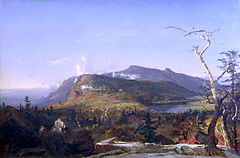Curriculum Materials: Art in America
|
|
Image 10 Jasper Cropsey Questions: |
Catskill Mountain House
Although his painting is called Catskill Mountain House, Cropsey did not make the hotel the focal point of the work. It is merely a distant landmark dwarfed by the vast expanse of wilderness. He probably included it to entice a prospective buyer or to please a hotel patron who wanted a souvenir. The real subject of the painting is nature.
Cropsey used several compositional devices to convey the unbounded space of the Catskills. By making the sky take up nearly half of the painting, he stressed the horizontal expanse of the land. The FOREGROUND to the right offers the viewer an elevated vantage point from which to take in the scene. Changes in color lead a viewer's eyes from the twisted tree and rocks in the foreground to the lake and resort in the MIDDLEGROUND, and finally to the mountain, valley, and sky in the BACKGROUND. Using atmospheric perspective, the artist blurred the edges and softened the colors of the forms in the background to represent the way objects actually appear in the distance.
Cropsey's elevated viewpoint is typical of most Hudson River School paintings. It visually expresses the political philosophy of the time, Manifest Destiny, which proposed that European Americans were destined by God to civilize, tame, and dominate this land.
The red and golden foliage show that it is autumn,
Cropsey's favorite season. Wispy
clouds weave in and out of the distant peaks, emphasizing
the height of the mountains. The dead trees in the
foreground represent the wilderness. In contrast, the
NEOCLASSICAL hotel
represents civilization and humankind's ability to impose
order on nature. A few birds in the branches of the dead
tree are the only other signs of life in this vast
landscape.
|
|
